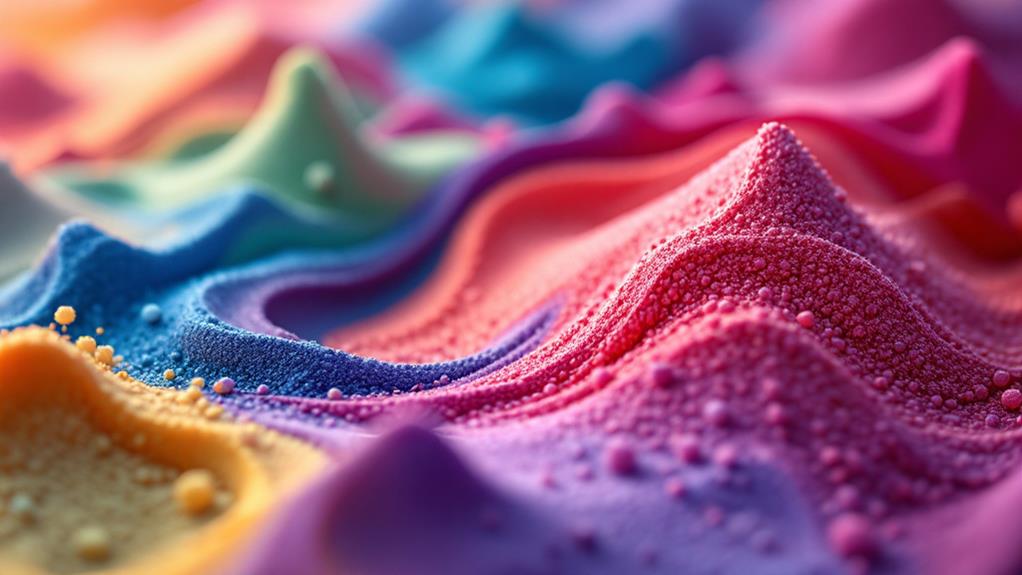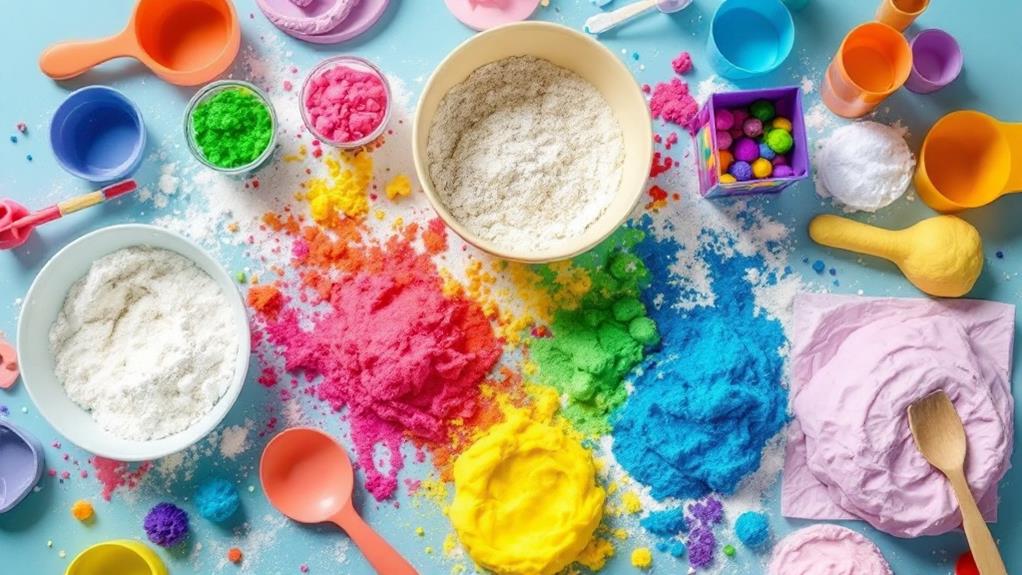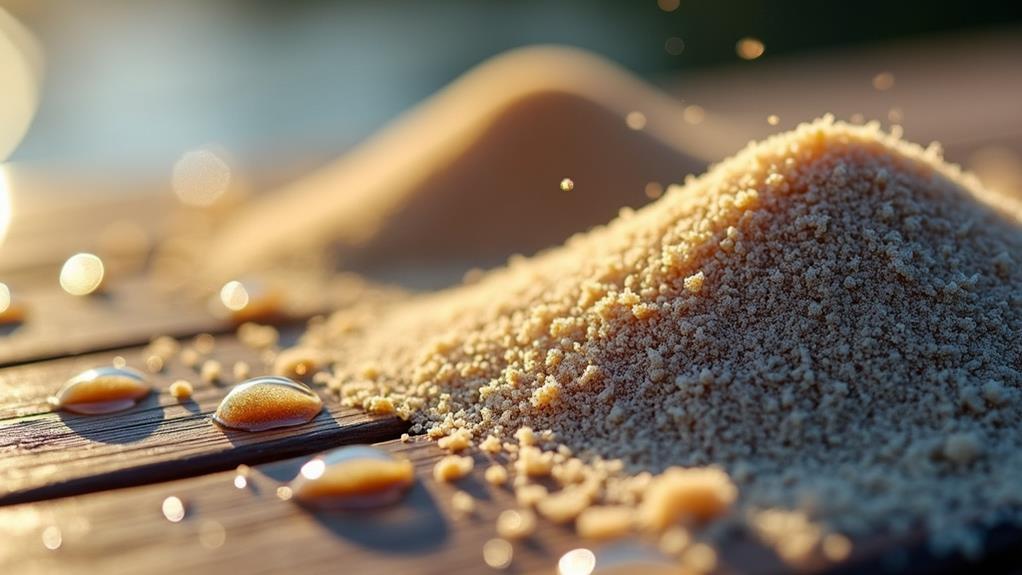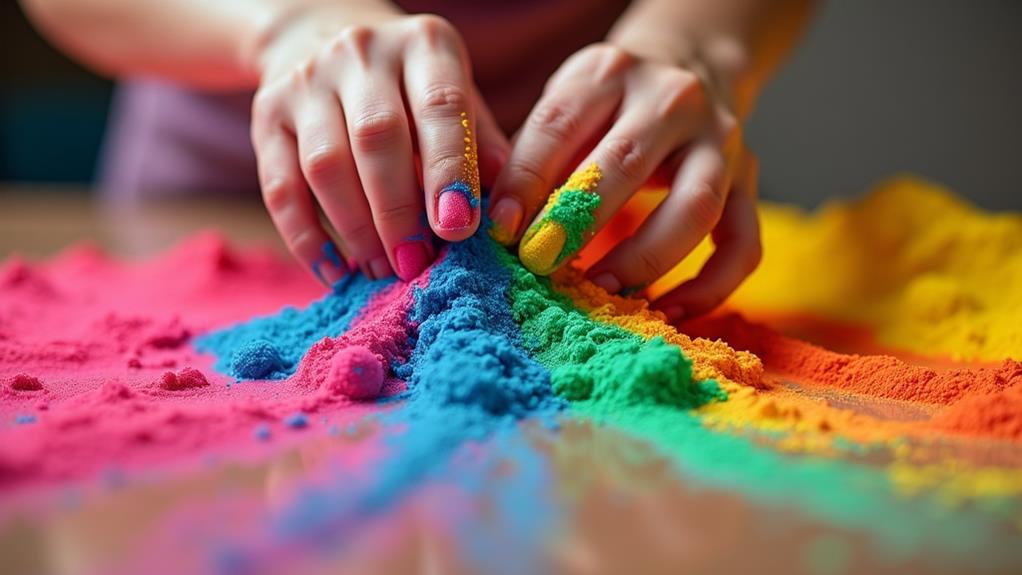Can You Put Kinetic Sand in Slime?
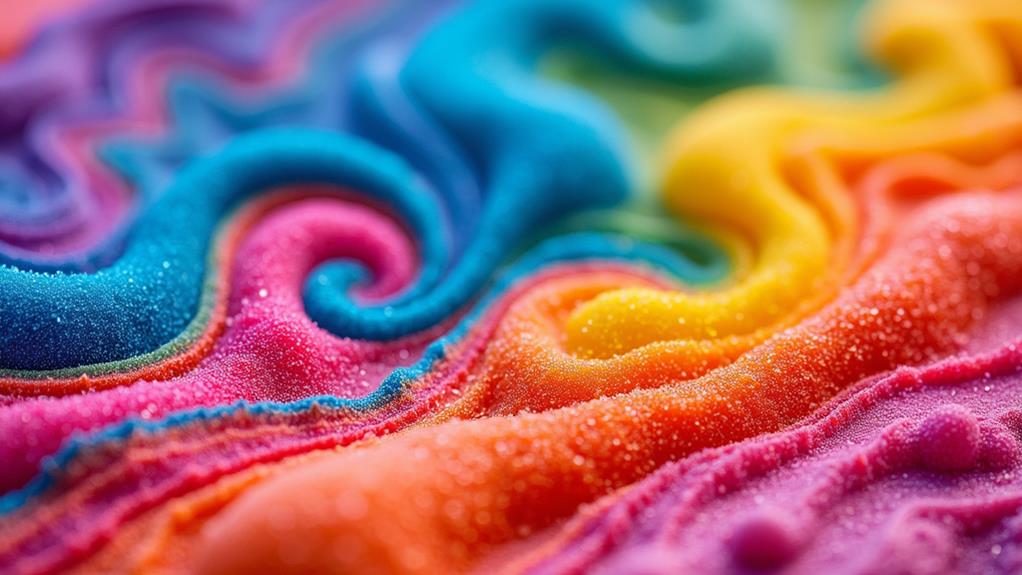
Have you ever wondered if you can put kinetic sand in slime? Combining these two popular materials might seem like a fun experiment, but there are a few things you need to know before diving in. The moldable texture of kinetic sand and the stretchy nature of slime could create a unique sensory experience, but achieving the right consistency and dealing with the cleanup process are important considerations. Before you start mixing, let's explore the benefits and potential challenges of this intriguing combination.
What Is Kinetic Sand?
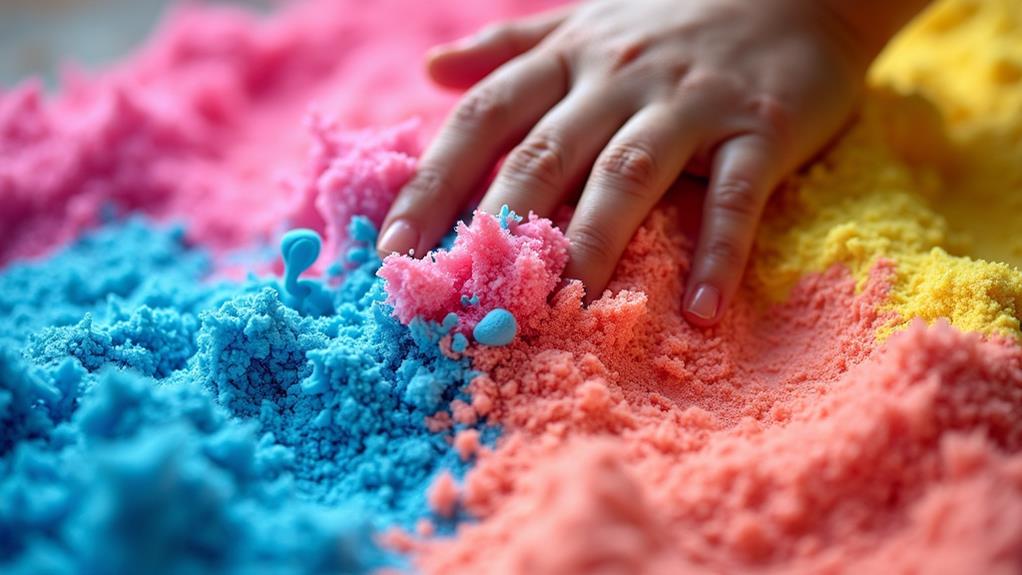
Kinetic Sand is a unique material that combines the natural graininess of sand with a polymer to create a moldable and reusable substance. Upon touching kinetic sand, you'll notice its smooth texture, which differentiates it from regular sand. This unique composition allows it to hold its shape without ever drying out.
Unlike traditional sand, kinetic sand sticks to itself, making it easy to clean up as it doesn't scatter. This self-adhesive property enables the construction of intricate designs that remain intact. Whether you're sculpting a castle or molding shapes, kinetic sand retains its form and doesn't crumble easily, allowing for repeated use and creativity.
Kinetic sand is also non-toxic, making it safe for children and providing peace of mind for parents. Additionally, the tactile experience offers therapeutic benefits; running your fingers through the smooth grains can help reduce anxiety and serve as a stress-relief tool. For those seeking a versatile, clean, and safe material for creative play, kinetic sand is an excellent choice.
Benefits of Combining
Combining kinetic sand with slime creates a superior sensory experience that is both stretchy and tactile, making it ideal for engaging play. The mixture is visually captivating, especially with clear slime that accentuates the sand's colors and shimmer. This blend also enhances creative possibilities for building and sculpting, making playtime more imaginative and therapeutic.
Enhanced Sensory Experience
Combining kinetic sand with slime creates a unique sensory experience that enhances tactile engagement through their contrasting textures. The stretchy, gooey feel of slime merges with the gritty, moldable texture of kinetic sand, making playtime more engaging and improving tactile awareness and fine motor skills.
Here's a quick comparison to help visualize the benefits:
| Aspect | Kinetic Sand + Slime |
|---|---|
| Texture | Gritty and moldable |
| Stretchiness | Enhanced with added stretch |
| Durability | Long-lasting, doesn't dry out |
| Visual Appeal | Engaging colors and shapes |
The kinetic sand enhances the stretchiness of the slime, allowing for stretching, pulling, and sculpting in ways not possible with slime alone. Plus, the kinetic sand doesn't dry out, so your kinetic sand slime remains a durable sensory tool.
Visually, clear slime enriched with kinetic sand is captivating, making it easier to explore colors and shapes. This combination also amplifies therapeutic benefits such as anxiety reduction and stress relief, providing a calming effect during playtime. In summary, combining these two materials results in a highly satisfying and beneficial sensory experience.
Creative Play Opportunities
Imagine transforming the improved sensory experience of kinetic sand and clear slime into a playground for creativity. By combining these two materials, you unlock a world of creative play opportunities. The unique texture of the mixture is smoother and less sticky than traditional slime, making it easier to sculpt and build. Children can create intricate shapes and structures, leveraging the properties of both materials to fuel their imaginative play.
Kinetic sand's non-drying quality ensures the mixture remains pliable, guaranteeing endless playtime without frequent replacements. This allows for various ways to combine clear slime with kinetic sand, enhancing visual appeal and engagement.
This combination not only promotes creativity but also offers therapeutic benefits. The tactile play and creative expression can help reduce anxiety, providing a calming activity for both children and adults. Experimenting with different slime recipes and textures can further enrich the experience, making it a versatile tool for both fun and relaxation. Dive into this creative adventure and see where your imagination takes you!
Required Materials

To get started on making kinetic sand slime, you'll need a few essential materials. First, you'll need clear slime as your base, which you can create by combining clear glue with an activator. The activator transforms the glue into a stretchy, slime-like substance.
Next, you'll need a bag of kinetic sand. A $15 bag is usually sufficient to mix with your slime to achieve the perfect texture. The sand adds a unique, grainy feel that's fun to play with. Ensure you have extra activator on hand, as you might need more during the mixing process to prevent the mixture from becoming too sticky or runny.
You'll also need some mixing tools. Spatulas work well, but using your hands can provide a more tactile experience. The key is to combine everything thoroughly. Finally, an airtight container is crucial for storing your kinetic sand slime, keeping it from drying out and maintaining its texture for future use.
With these materials ready, you're all set to create your own kinetic sand slime!
Basic Mixing Steps
Creating kinetic sand slime is a straightforward process that begins with your base slime recipe, such as clear slime or safe puffy slime. Start by preparing a smaller batch of slime to ensure better mixing and to minimize mess when adding kinetic sand.
Gradually incorporate kinetic sand into the slime. Begin with a small amount and gently knead it into the slime. Observe the texture as you mix. If it becomes too sticky, add a bit of activator to help with binding. Continue adding kinetic sand in small increments until you achieve your desired consistency. Unlike regular sand, kinetic sand has a unique texture that binds well with slime, enhancing the sensory experience.
Experiment with different ratios of kinetic sand to slime to see what works best for you. Some may prefer a more stretchy slime, while others may enjoy a firmer texture. Adjusting these ratios allows you to personalize your kinetic sand slime, creating a fun and satisfying experience. Take your time and enjoy the process of finding the perfect blend!
Recipe Variations
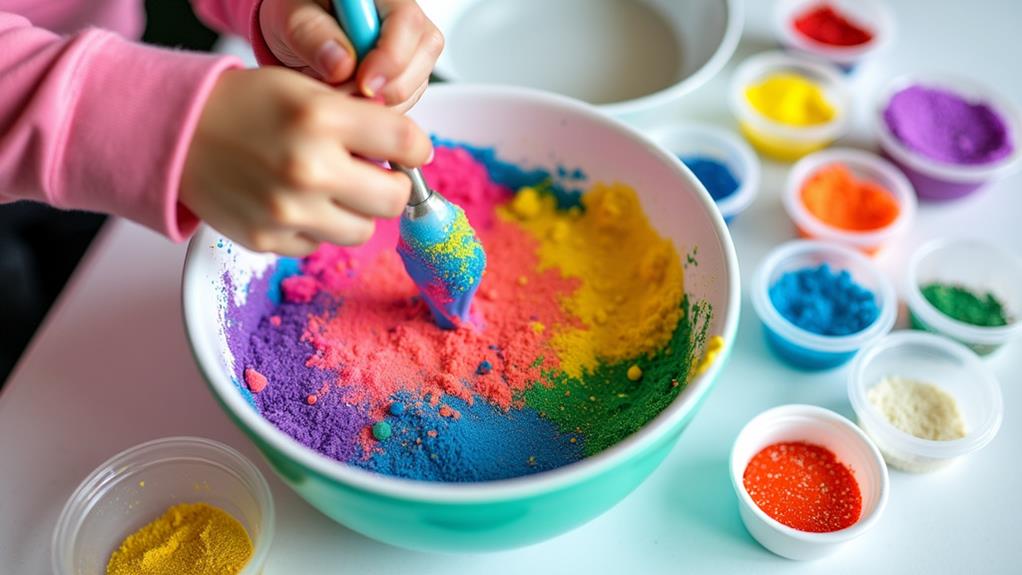
Experimenting with recipe variations is essential when creating kinetic sand slime. By mixing kinetic sand with different types of slime bases, you can explore various textures and visual effects. For example, using clear slime as a base can enhance the visual appeal by keeping the sand visible, resulting in a striking look. Alternatively, Safe Puffy Slime can offer a unique texture and experience.
Adjusting the ratios of kinetic sand to slime is another way to tailor your creation. A higher ratio of kinetic sand will make the slime firmer and more moldable, while a lower ratio will keep it stretchier and softer. Here's a useful table to guide you through some recipe variations:
| Type of Slime | Kinetic Sand Ratio | Texture Result |
|---|---|---|
| Clear Slime | 1:1 | Balanced, visually appealing |
| Clear Slime | 2:1 | Firmer, more moldable |
| Safe Puffy Slime | 1:1 | Soft, fluffy, slightly gritty |
| Safe Puffy Slime | 2:1 | Firmer, fluffy, moldable |
This table provides a quick reference for achieving different textures and appearances with kinetic sand slime.
Playing Tips
Playing with kinetic sand slime can be a fun and manageable activity if you follow some simple tips to keep things under control.
- Establish a Designated Play Area: Use a tray or table to contain the mess, making cleanup easy and ensuring the kinetic sand and slime stay in one place.
- Mix Gradually: Gradually incorporate kinetic sand into the slime to control the texture and avoid making the mixture too sticky or unmanageable.
- Encourage Creativity: Let kids experiment with different ratios of kinetic sand to slime, creating unique textures and play experiences.
- Supervise Playtime: Supervise to manage potential messiness and set boundaries for where the materials can be used, keeping the play area tidy.
- Storage: Store kinetic sand slime in an airtight container to maintain its consistency.
Cleaning Up

Cleaning up kinetic sand slime after playtime doesn't have to be a daunting task. With a few effective techniques, you can streamline the process. Start by using vinegar as a cleaning solution to remove slime residue from most surfaces. Simply apply a small amount and wipe it clean. For dried slime on carpets or furniture, use scraping tools to lift it off gently without causing damage.
To minimize messes from the outset, establish clear boundaries and rules for slime play. Designate a specific area for slime activities or use protective coverings to contain the mess. Storing kinetic sand slime in airtight containers will also prevent spills and keep it fresh for future use.
Regular supervision during playtime can help catch messes before they escalate. For additional guidance, consider watching video tutorials on cleaning kinetic sand slime, which offer step-by-step instructions and useful tips. By following these strategies, cleaning up kinetic sand slime will become a manageable and straightforward task.
Common Issues
Mixing kinetic sand into slime can result in a sticky, messy mixture that often requires extra activator to achieve the desired consistency. This combination may also complicate the cleaning of slime stains, particularly on carpets or furniture. Establishing clear rules and supervising play can help manage these mixtures more effectively and reduce mess-related issues.
Cleaning Slime Stains
Dealing with slime stains can be a common frustration, especially when it gets stuck on carpets, furniture, and other household surfaces. Fortunately, you can manage this issue effectively with a few proven cleaning strategies.
Initially, vinegar is an excellent cleaning solution for slime stains. Simply apply it to the affected area and let it sit for a few minutes before wiping it off with a cloth. This method works on both fabrics and hard surfaces.
Another handy method involves using scraping tools like plastic spatulas or credit cards. These tools can help lift dried slime without damaging the surface underneath. Just be gentle to avoid scratches.
To minimize future slime messes, establish designated play areas. Designate specific areas where slime can be used, such as a play table or a mat. This can make cleanup much easier and keep your home looking tidy.
Here's a quick summary:
- Vinegar: Apply to stains and wipe off for effective cleaning.
- Scraping tools: Use plastic spatulas or credit cards to lift dried slime.
- Designated play areas: Establish boundaries to contain the mess.
Managing Sticky Mixtures
Managing sticky mixtures like kinetic sand and slime can be more challenging than dealing with straightforward slime stains. When combined, kinetic sand and slime create a mixture that is stickier than expected due to the unique texture of kinetic sand.
To manage this, using extra activator helps achieve the desired consistency, reducing stickiness and making the mixture easier to handle. The texture will resemble traditional slime but with added complexity from the kinetic sand.
Supervise the mixing process closely to minimize messes and ensure proper handling. Store the kinetic sand-slime mixture in an airtight container to maintain its texture and prevent spills, allowing you to enjoy your creation without added mess.
User Feedback
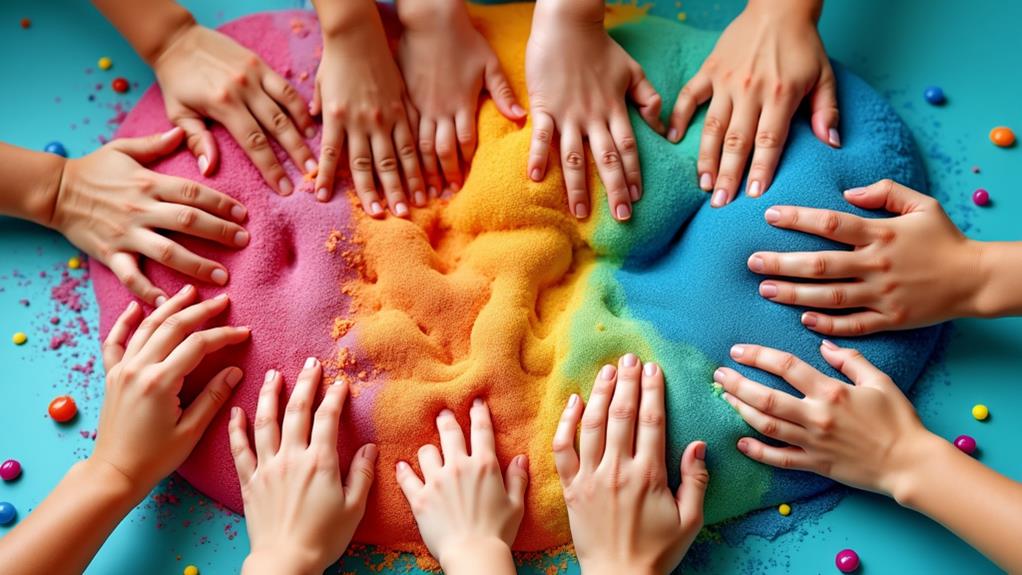
User feedback overwhelmingly shows that mixing kinetic sand with slime creates a unique and enjoyable texture, frequently described as stretchy and engaging. Every single user who has tried this combination finds that the kinetic sand blends better with slime compared to regular sand, making the experience less messy. The visual appeal is also improved, especially when clear slime is used, allowing the sand to remain visible and contribute an extra dimension of fun.
Users have shared their thoughts on this combination, often highlighting the need for an extra activator to get the right consistency. This step guarantees the slime doesn't become too sticky or too runny, which can be a common issue. Despite some challenges with messiness, the community remains enthusiastic, offering tips and tricks to manage it effectively.
Here's a summary of the key points from user feedback:
- Better Blending: Kinetic sand mixes more smoothly with slime than regular sand, reducing mess.
- Visual Appeal: Clear slime with kinetic sand looks engaging, adding a visual treat to the tactile experience.
- Consistency Tips: Extra activator might be required to achieve the perfect slime consistency.

